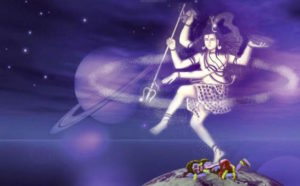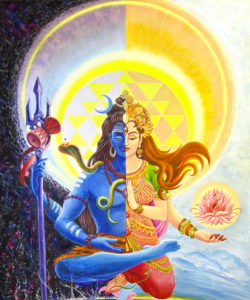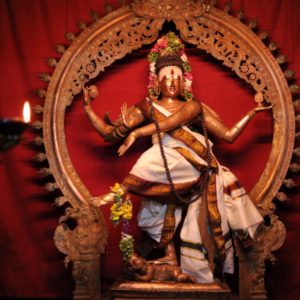Shiva – The Cosmic Dancer

By Kanaka Ramakrishna
The Worship of Shiva as ”˜Mahayogi’ and ”˜Pasupati’ as found in the Indus valley civilization in the north west of India 5000 years ago, was later integrated into the early Vedic Aryan civilisation as ”˜Rudra’, and later as ”˜Shiva’.
Though the worship of Rudra by the early Aryans started the proper foundation for Saivism, Siva occupied the high position later, and was depicted with three faces, perhaps to indicate his supreme power, which became trimurtis later as Brahma and Vishnu and Siva. To day Saivism is one of the three most influential denominations and a widely followed sect of Hinduism.
Shiva is worshipped as ”˜Parameshwara’, the Lord of the universe. Every year there is a sacred and significant night assigned for the special worship of Shiva called ”˜Shivaratri’. Though there are some interesting stories in the puranas associated to this, there is a deeper meaning in the worship of Shiva particularly on this sacred night. Shivaratri falls every year on the fourteenth day of the new moon in the month of magha. (February/March). According to the tradition the planetary positions on this night are such that there is a powerful, and natural upsurge of spiritual energy in nature as well as in the human body. Hence ”˜Shivaratri’ is considered sacred to worship of Shiva with devotion for spiritual growth.
The iconic picture of Siva with three eyes represent the sun, the moon and the fire, the three sources of light, life and heat. The garland of skulls (mundamala) that he wears and the ashes from the funeral pyre smeared over his body, indicate that he is the Lord of destruction. The kapala, (skull) is another symbol that points to his all-destroying power.
The trishula (trident) in Shiva’s right hand represents the emblem of His sovereignty and also the three gunas of Prakriti – Sattva, Rajas and Tamas, which are fully under his control and Shiva wields the world through these three Gunas. Ganga from his head represents purity and the nectar of immortality. Elephant symbolically represents pride. Wearing the skin of the elephant signifies that He has conquered pride. The never satiating desire can be compared to a tiger, which Shiva killed and wore its skin denoting his complete mastery over desire. Wearing serpents denote his eternity, as serpents live a long life. The third eye in his forehead indicates the eye of wisdom and also it represents his destructive power. The akshamala (rosary) shows that he is the supreme master of all secular and spiritual knowledge.
Shiva is also worshipped in the form of ”˜Linga’. As the conquerer of the god of death, he is Mrutyunjaya and as the Lord of Yoga, he is worshipped as ”˜Dakshinamurthy’, the very model of a perfect Guru. Since Shiva and his Shakti are one and the same, he is called ”˜Ardhanaareeshwara’

The earliest use of the name Nataraja for Shiva is found in Panini’s ”˜Maheswara Sutra’. It is mentioned that Siva sounded his damaru fourteen times, producing fourteen sound patterns, which form the basic structure of entire Sanskrit grammar and forms of all languages and arts.
The iconic dancing forms of Shiva Nataraja are generally divided into eight categories of which Tandava murti is one of them. Of the 108 known modes of dancing, all are attributed to Siva as the originator. However of the popular 9 modes, the Nataraja aspect is the best. Of all the Nataraja temples in India, the most famous and beautiful image of Nataraja is in the temple at Chidambaram. It is the most visually dramatic and culturally significant dancing form of Shiva.

In this image we find a deeply moving symbol of the ultimate mysterious and paradoxical nature of the divine creation and destruction, order and chaos, asceticism and sensuality, immanence and transcendence, life and death, being and non-being, all co-exist and balance, and blend with each other in him. The visual form of Nataraja has four arms, dancing the Ananda Tandava within a circle of flames. He is lifting his left leg and standing with his right leg on a dwarf (apasmara purusha), symbolising ignorance and illusion. The lotus pedestal is the symbol of the creative forces of the universe.
Nataraja dances in the middle of the fire-studded ring symbolising the energy of the universe and its creation and dissolution, and the endless cycle of birth and death. The fiery ring (prabhamandala) represents the universe. The flowing hair shows that he is a yogi. The snake around the waist represents the kundalini shakti or the divine energy that resides in everything.
Nataraja’s upper right hand holds the drum (damaru), which is in the shape of an hourglass, symbolising sound (Shabdha Bramha ”˜OM’), originating creation and marking the passage of time. With the primordial sound of this drum he beats the rhythm of his dance and the ceaseless pulse of the universe. In his upper left hand he holds the fire of destruction, the pralayagni, representing the fire that destroys the world of time and space at the time of dissolution. Burning the veil of time also opens our minds to eternity. The lower right hand is held in the abhaya (assurance) pose, signifying a gesture of grace and protection to His devotees. The uplifted left leg signifies His grace that liberates souls from bondage. The lower left hand which points to the uplifted left leg, shows the assurance that Shiva’s foot is the refuge for all who surrender to Him.
Nataraja is a symbolic synthesis of the most important aspects and the central tenets of Hinduism. Though the figure of Nataraja is a static sculpture, it represents the intense activity, a duality of stillness and motion. The stoic face represents his unaffected composure, indicating that He is above and beyond all activities. His face shows the blissfully dreaming, silent countenance, contrasting with passionate agility of the limbs representing both the Absolute and its Maya, as a single trans-dual form.
The dance of Nataraja is a pictorial allegory of the five principle manifestations of eternal energy. “The dance of Shiva represents his five activities – Shrishti (creation, evolution), Sthithi (preservation, protection), Samhaara (destruction, involution), Tirobhava (illusion), and Anugraha (emancipation, grace). The overall temper of the image is paradoxical, uniting the inner tranquillity and outer activity of Shiva”¦a more fluid and energetic representation of a moving figure than the dancing figure of Shiva – Nataraja is hardly found anywhere in the world”
In this world, we can clearly witness the incessant live dance of Shiva who is in the form of rising waves of the ocean, in the huge inundation and volcanic eruptions, in earth-quakes, lightning, thunder, cyclonic storms, in the movement of planets, constellations and in everything and everywhere. There is no atom where He is not seen dancing in this universe eternally.
We, human beings, are continuously re-born while alive. Every living moment a portion of the billions of atoms in our body dies and new ones are born. This process is going on continuously. 98 percent of our body is replaced at least once a year. As such we are equally as much engaged in Shiva’s exquisite cosmic dance of creation and destruction with the rhythm to maintain the balance in the universe.
The real dancers are we, the human beings. We are the dance of Shiva everywhere and every moment continuously – in our movements, in our thoughts, in our breathing (pranas), oscillations of our minds, in the movements of our senses. In fact it is our own self, which is the part and parcel of Universal Consciousness, is the participator in the play of Shiva’s dance, but we forget our real nature because of the veil of Maya, (ignorance). His power of destruction and recreation are constantly used to destroy the illusions and imperfections of this world for the benefit of mankind.
A scientific explanation is very well brought out by Fritzof Capra in his article, “The Dance Of Shiva”¦”, and later in “The Tao of Physics”, he beautifully relates Nataraja’s dance with modern physics. He said, “ Every subatomic particle not only performs an energy dance, but also IS an energy dance; a pulsating process and creation and destruction”¦without end”¦For the modern physicists Siva’s dance is the dance of subatomic matter. In Hindu mythology, it is a continual dance of creation and destruction, involving the whole cosmos; the basis of all existence and of all natural phenomena.”
Here is an excerpt from a beautiful poem by Ruth Peel that sums up:
“The source of all movement,
Shiva’s dance gives rhythm to the universe,
He dances in evil places, in sacred,
He creates and preserves, Destroys and releases.
We are part of this Dance
This eternal rhythm
And woe to us, if blinded by illusion
We detach ourselves
From the Dancing Cosmos
This universal harmony”¦.”
Short URL: https://indiandownunder.com.au/?p=10502
